No Man’s Sky (PS4) Review
"The Reality of Space > Your Space Fantasies"
It has been a long road for Hello Games with
No Man's Sky. A small indie team behind arguably the most anticipated game this year in the gaming industry should be a feel good story right? Sony's marketing hype train, numerous delays and promises not being delivered from the initial reveal have been the game's journey up to it's launch. Even with the weeks leading up to it's release, the game has been a secret in terms what in the world we do in it. Yet through all of that,
No Man's Sky is finally here. Is it the ultimate space exploration game we've been waiting for?
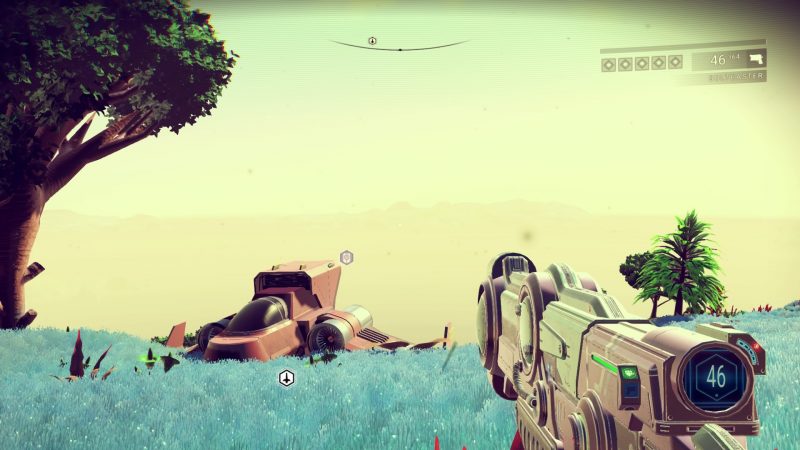
The answer has been quite divisive.
No Man's Sky lets you live your space dreams of exploring many planets and claiming discoveries for yourself. However, the majority of the time playing makes you realize what the reality of space is. In other words, the game becomes more of a chore with it's gameplay loop than trying to recreate your favorite moments from space movies. You first start out in a random planet stranded with a busted ship. The game first tasks you to repair parts of your ship to get you going. As you gather the necessary resources by mining up elements, you quickly realize what
No Man's Sky is in a nutshell. Explore and mine up resources, leave a planet and either travel into another one or warp into a new system and repeat. That's the game at it's core and the result is a boring, repetitive grind.
You can spend minutes to a few hours in one planet in terms you what to get done there. Besides the core gameplay loop, there's also creatures and plants to scan for units, the in-game currency. Creatures range from big bulky animals to small birds that are frustrating to scan especially if you want 100% discovery of species for the planet. Each of the quintillion planets have varying conditions, but contain the same elements you need to survive. From extreme weather of heat, cold or toxin, creature frequency and how sentinels will behave, planets can mix things up at times to make your journey a struggle specifically early on. At the end of the day, it's not enough even with dozens of save points, trading posts and exploring an alien race's origins.
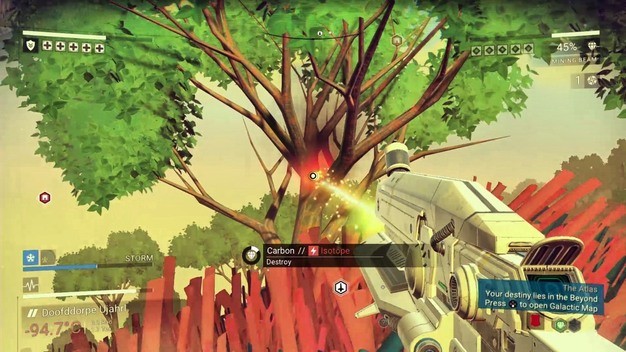
The alien races in
No Man's Sky are there for the sake of making things not lonely for the player. We have the lizard-like Vykeen, the robotic Korvax and the midget-looking Gek. In space stations and certain outposts, you'll likely run into one of these guys and either help or harm you. The more you help them out or in other words, pick the right choices, your relationships with them improve. They can give you blueprints that provide upgrades to your suit, ship and multi-tool. In the planets, you can find stones that you can learn words of their language. These help out most in your conversations with aliens to understand them better. In addition, monoliths and ruins can be found as well to learn more about their history. The payoff to learning more about these aliens isn't much. I wished there's specific story-based expansions for each of them however.
The multi-tool is your primary weapon in the game. It's purpose is to mine up elements and shoot down threats. Shooting mechanics are light against aggressive species and sentinels, the game's cops even though they don't explain why they're in every planet. There is a wanted level similar to Grand Theft Auto in terms of how threatening the sentinels are. From drones to big robots, sentinels can be a nuisance. Personally I never experienced the higher wanted levels because those are rare to experience. Multi-tool upgrades consist of improved mining, grenades and fire rate to the boltcaster. Don't expect the best shooting mechanics in
No Man's Sky with multi-tools, but it still gets the job done.
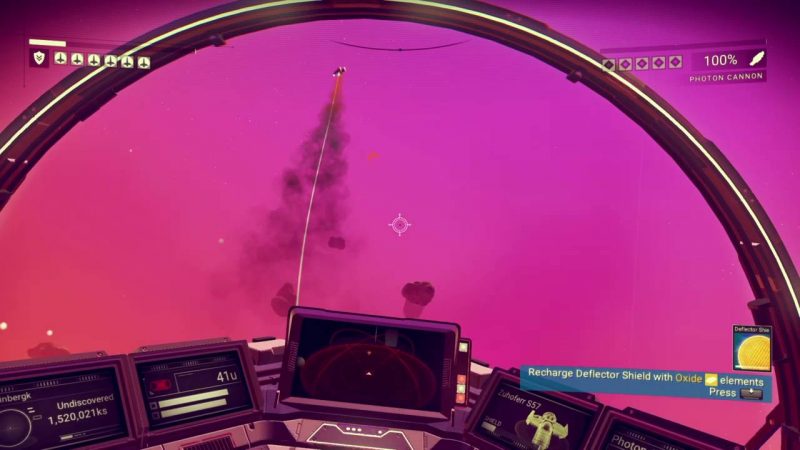
Over at space, Hello Games also dropped the ball here a bit. There's asteroids to blast down for more resources and space stations to visit. The bummer is that the freighters you see in the system are just there for show and not tell. They do have turrets to defend themselves whenever battles happen. Combat against other starships is barebones just like the on-foot shooting, but still functional. At least you can check out other starships docked at a space station to trade supplies or even buy their ship. That is pivotal especially looking for a ship with more inventory slots to fit in what you need. I only died twice throughout my playtime in space because I was outnumbered against a few starships. Even when powered up, your starship doesn't do a good job in those moments, so it's better to pick your battles in space.
Besides resource gathering and traveling through the galaxy, the other core component in
No Man's Sky is inventory management. Inventory management hasn't been fun ever since it's early days in games the same is the case here. Early on is more frustrating because you want to have slots for upgrades, but you do need the required elements for survival more. More inventory slots for your exosuit open up to spend units on at drop pods in planets. Some of the handling of more key items could of been better. They take up an entire slot compared to having 250 of one element to fill up a slot. Having multiple items to craft for warp cells or a big upgrade consuming up your suit can be a pain, but the reward is nice such as seeing your ship travel more light years than it used to.
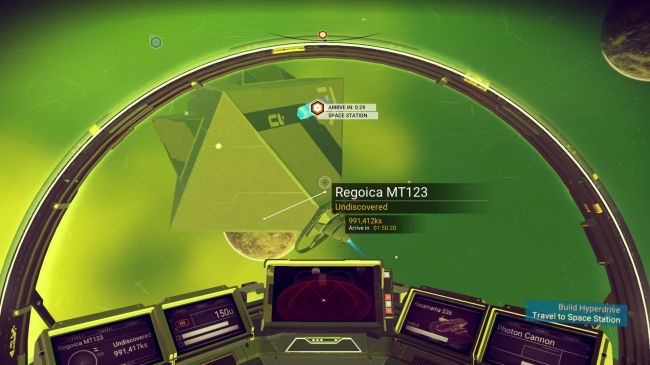
Before
No Man's Sky came out, many were wondering if there's some structured path to follow. There is somewhat but the payoff is not what people expect. Every now and then in space, you'll encounter space anomalies. These are different from the space stations where you meet a Korvax guy about the Atlas path. You decide on following the Atlas path or finding a black hole that is a shortcut to the galactic core. The Atlas path leads you into numerous Atlas facilities where you need to complete the game's milestones to progress. Milestones range from staying at a planet for a long period of time, surviving in extreme conditions or speaking to aliens, etc. Completing the Atlas path and getting to the galactic core does achieve an "ending" of sorts, but that moment is quite underwhelming.
At moments,
No Man's Sky looks breathtaking. Finding that planet with the perfect colors and views can provide great postcards without a proper photo mode. The draw distance is also impressive, but the framerate at 30 fps can be all over the place. At times when I'm mining a big mountain of gold, the framerate chugs below 30. The most disappointing thing in the game however it's performance. Crashes happen frequently whenever I'm in the middle of warping, choosing a system to warp to and many more. Even I'm just out and about mining plants for carbon, the game hard crashes. They were bad at launch and still are a couple patches later. I do recommend saving at outposts and space stations regularly to avoid losing significant progress.
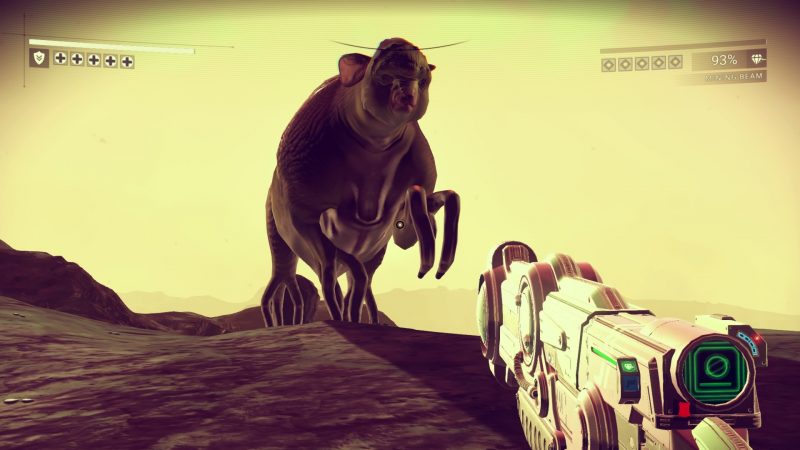
A small team releasing the biggest indie game in terms of hype at retailers is indeed an impressive feat. However,
No Man's Sky doesn't get a pass because of it's repetitive gameplay loop and lackluster performance. No matter how many times that "small team excuse" is used, this is the most crashes I encountered for a big game. I don't think any other company would approve of this being released in this state. Sony had a big marketing push and just wanted it to be out after delays. That also could be the reason Hello Games not living up to the promises since it's 2012 reveal. The package is still hefty with many planets to discover, but space is more a grind than what people thought it would be.
No Man's Sky is a disappointment currently, but I'm curious to see what the game is a year later.
Pros
- Postcard worthy moments at space and in planets
- Still cool to claim discovery of planets and species for yourself
Cons
- Even a couple patches later, lackluster performance with periodic crashing
- Gameplay loop is boring and repetitive
- Inventory management is the worst early on
- Framerate chugs at certain moments
- Scanning birds to complete a planet's zoology is frustrating
- Atlas path's payoff is underwhelming
 The answer has been quite divisive. No Man's Sky lets you live your space dreams of exploring many planets and claiming discoveries for yourself. However, the majority of the time playing makes you realize what the reality of space is. In other words, the game becomes more of a chore with it's gameplay loop than trying to recreate your favorite moments from space movies. You first start out in a random planet stranded with a busted ship. The game first tasks you to repair parts of your ship to get you going. As you gather the necessary resources by mining up elements, you quickly realize what No Man's Sky is in a nutshell. Explore and mine up resources, leave a planet and either travel into another one or warp into a new system and repeat. That's the game at it's core and the result is a boring, repetitive grind.
You can spend minutes to a few hours in one planet in terms you what to get done there. Besides the core gameplay loop, there's also creatures and plants to scan for units, the in-game currency. Creatures range from big bulky animals to small birds that are frustrating to scan especially if you want 100% discovery of species for the planet. Each of the quintillion planets have varying conditions, but contain the same elements you need to survive. From extreme weather of heat, cold or toxin, creature frequency and how sentinels will behave, planets can mix things up at times to make your journey a struggle specifically early on. At the end of the day, it's not enough even with dozens of save points, trading posts and exploring an alien race's origins.
The answer has been quite divisive. No Man's Sky lets you live your space dreams of exploring many planets and claiming discoveries for yourself. However, the majority of the time playing makes you realize what the reality of space is. In other words, the game becomes more of a chore with it's gameplay loop than trying to recreate your favorite moments from space movies. You first start out in a random planet stranded with a busted ship. The game first tasks you to repair parts of your ship to get you going. As you gather the necessary resources by mining up elements, you quickly realize what No Man's Sky is in a nutshell. Explore and mine up resources, leave a planet and either travel into another one or warp into a new system and repeat. That's the game at it's core and the result is a boring, repetitive grind.
You can spend minutes to a few hours in one planet in terms you what to get done there. Besides the core gameplay loop, there's also creatures and plants to scan for units, the in-game currency. Creatures range from big bulky animals to small birds that are frustrating to scan especially if you want 100% discovery of species for the planet. Each of the quintillion planets have varying conditions, but contain the same elements you need to survive. From extreme weather of heat, cold or toxin, creature frequency and how sentinels will behave, planets can mix things up at times to make your journey a struggle specifically early on. At the end of the day, it's not enough even with dozens of save points, trading posts and exploring an alien race's origins.
 The alien races in No Man's Sky are there for the sake of making things not lonely for the player. We have the lizard-like Vykeen, the robotic Korvax and the midget-looking Gek. In space stations and certain outposts, you'll likely run into one of these guys and either help or harm you. The more you help them out or in other words, pick the right choices, your relationships with them improve. They can give you blueprints that provide upgrades to your suit, ship and multi-tool. In the planets, you can find stones that you can learn words of their language. These help out most in your conversations with aliens to understand them better. In addition, monoliths and ruins can be found as well to learn more about their history. The payoff to learning more about these aliens isn't much. I wished there's specific story-based expansions for each of them however.
The multi-tool is your primary weapon in the game. It's purpose is to mine up elements and shoot down threats. Shooting mechanics are light against aggressive species and sentinels, the game's cops even though they don't explain why they're in every planet. There is a wanted level similar to Grand Theft Auto in terms of how threatening the sentinels are. From drones to big robots, sentinels can be a nuisance. Personally I never experienced the higher wanted levels because those are rare to experience. Multi-tool upgrades consist of improved mining, grenades and fire rate to the boltcaster. Don't expect the best shooting mechanics in No Man's Sky with multi-tools, but it still gets the job done.
The alien races in No Man's Sky are there for the sake of making things not lonely for the player. We have the lizard-like Vykeen, the robotic Korvax and the midget-looking Gek. In space stations and certain outposts, you'll likely run into one of these guys and either help or harm you. The more you help them out or in other words, pick the right choices, your relationships with them improve. They can give you blueprints that provide upgrades to your suit, ship and multi-tool. In the planets, you can find stones that you can learn words of their language. These help out most in your conversations with aliens to understand them better. In addition, monoliths and ruins can be found as well to learn more about their history. The payoff to learning more about these aliens isn't much. I wished there's specific story-based expansions for each of them however.
The multi-tool is your primary weapon in the game. It's purpose is to mine up elements and shoot down threats. Shooting mechanics are light against aggressive species and sentinels, the game's cops even though they don't explain why they're in every planet. There is a wanted level similar to Grand Theft Auto in terms of how threatening the sentinels are. From drones to big robots, sentinels can be a nuisance. Personally I never experienced the higher wanted levels because those are rare to experience. Multi-tool upgrades consist of improved mining, grenades and fire rate to the boltcaster. Don't expect the best shooting mechanics in No Man's Sky with multi-tools, but it still gets the job done.
 Over at space, Hello Games also dropped the ball here a bit. There's asteroids to blast down for more resources and space stations to visit. The bummer is that the freighters you see in the system are just there for show and not tell. They do have turrets to defend themselves whenever battles happen. Combat against other starships is barebones just like the on-foot shooting, but still functional. At least you can check out other starships docked at a space station to trade supplies or even buy their ship. That is pivotal especially looking for a ship with more inventory slots to fit in what you need. I only died twice throughout my playtime in space because I was outnumbered against a few starships. Even when powered up, your starship doesn't do a good job in those moments, so it's better to pick your battles in space.
Besides resource gathering and traveling through the galaxy, the other core component in No Man's Sky is inventory management. Inventory management hasn't been fun ever since it's early days in games the same is the case here. Early on is more frustrating because you want to have slots for upgrades, but you do need the required elements for survival more. More inventory slots for your exosuit open up to spend units on at drop pods in planets. Some of the handling of more key items could of been better. They take up an entire slot compared to having 250 of one element to fill up a slot. Having multiple items to craft for warp cells or a big upgrade consuming up your suit can be a pain, but the reward is nice such as seeing your ship travel more light years than it used to.
Over at space, Hello Games also dropped the ball here a bit. There's asteroids to blast down for more resources and space stations to visit. The bummer is that the freighters you see in the system are just there for show and not tell. They do have turrets to defend themselves whenever battles happen. Combat against other starships is barebones just like the on-foot shooting, but still functional. At least you can check out other starships docked at a space station to trade supplies or even buy their ship. That is pivotal especially looking for a ship with more inventory slots to fit in what you need. I only died twice throughout my playtime in space because I was outnumbered against a few starships. Even when powered up, your starship doesn't do a good job in those moments, so it's better to pick your battles in space.
Besides resource gathering and traveling through the galaxy, the other core component in No Man's Sky is inventory management. Inventory management hasn't been fun ever since it's early days in games the same is the case here. Early on is more frustrating because you want to have slots for upgrades, but you do need the required elements for survival more. More inventory slots for your exosuit open up to spend units on at drop pods in planets. Some of the handling of more key items could of been better. They take up an entire slot compared to having 250 of one element to fill up a slot. Having multiple items to craft for warp cells or a big upgrade consuming up your suit can be a pain, but the reward is nice such as seeing your ship travel more light years than it used to.
 Before No Man's Sky came out, many were wondering if there's some structured path to follow. There is somewhat but the payoff is not what people expect. Every now and then in space, you'll encounter space anomalies. These are different from the space stations where you meet a Korvax guy about the Atlas path. You decide on following the Atlas path or finding a black hole that is a shortcut to the galactic core. The Atlas path leads you into numerous Atlas facilities where you need to complete the game's milestones to progress. Milestones range from staying at a planet for a long period of time, surviving in extreme conditions or speaking to aliens, etc. Completing the Atlas path and getting to the galactic core does achieve an "ending" of sorts, but that moment is quite underwhelming.
At moments, No Man's Sky looks breathtaking. Finding that planet with the perfect colors and views can provide great postcards without a proper photo mode. The draw distance is also impressive, but the framerate at 30 fps can be all over the place. At times when I'm mining a big mountain of gold, the framerate chugs below 30. The most disappointing thing in the game however it's performance. Crashes happen frequently whenever I'm in the middle of warping, choosing a system to warp to and many more. Even I'm just out and about mining plants for carbon, the game hard crashes. They were bad at launch and still are a couple patches later. I do recommend saving at outposts and space stations regularly to avoid losing significant progress.
Before No Man's Sky came out, many were wondering if there's some structured path to follow. There is somewhat but the payoff is not what people expect. Every now and then in space, you'll encounter space anomalies. These are different from the space stations where you meet a Korvax guy about the Atlas path. You decide on following the Atlas path or finding a black hole that is a shortcut to the galactic core. The Atlas path leads you into numerous Atlas facilities where you need to complete the game's milestones to progress. Milestones range from staying at a planet for a long period of time, surviving in extreme conditions or speaking to aliens, etc. Completing the Atlas path and getting to the galactic core does achieve an "ending" of sorts, but that moment is quite underwhelming.
At moments, No Man's Sky looks breathtaking. Finding that planet with the perfect colors and views can provide great postcards without a proper photo mode. The draw distance is also impressive, but the framerate at 30 fps can be all over the place. At times when I'm mining a big mountain of gold, the framerate chugs below 30. The most disappointing thing in the game however it's performance. Crashes happen frequently whenever I'm in the middle of warping, choosing a system to warp to and many more. Even I'm just out and about mining plants for carbon, the game hard crashes. They were bad at launch and still are a couple patches later. I do recommend saving at outposts and space stations regularly to avoid losing significant progress.
 A small team releasing the biggest indie game in terms of hype at retailers is indeed an impressive feat. However, No Man's Sky doesn't get a pass because of it's repetitive gameplay loop and lackluster performance. No matter how many times that "small team excuse" is used, this is the most crashes I encountered for a big game. I don't think any other company would approve of this being released in this state. Sony had a big marketing push and just wanted it to be out after delays. That also could be the reason Hello Games not living up to the promises since it's 2012 reveal. The package is still hefty with many planets to discover, but space is more a grind than what people thought it would be. No Man's Sky is a disappointment currently, but I'm curious to see what the game is a year later.
A small team releasing the biggest indie game in terms of hype at retailers is indeed an impressive feat. However, No Man's Sky doesn't get a pass because of it's repetitive gameplay loop and lackluster performance. No matter how many times that "small team excuse" is used, this is the most crashes I encountered for a big game. I don't think any other company would approve of this being released in this state. Sony had a big marketing push and just wanted it to be out after delays. That also could be the reason Hello Games not living up to the promises since it's 2012 reveal. The package is still hefty with many planets to discover, but space is more a grind than what people thought it would be. No Man's Sky is a disappointment currently, but I'm curious to see what the game is a year later.